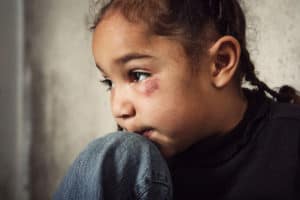In 2011, Sadie Dodson and her family welcomed their youngest child into their family forever. They had only ever planned on adopting from foster care. But once they had a window into the world of foster care, they knew they could not walk away.
Over the last ten years, Sadie and her family have remained involved in foster care. And during this time, they have helped countless children—from infants to teenagers—work towards healing from the abuse and neglect that led to them being removed from their homes.
Sadie’s perspective on child abuse prevention is an important one. Not only does Sadie have experience as a foster/adoptive parent with a background in psychology, but she also currently serves as a Family Care Manager for Project 1.27, where she helps recruit, train, and support foster/adoptive families.
Having seen the child welfare system from so many angles, Sadie provides practical and poignant insight into the warning signs of child abuse and neglect.
Abuse may look different case by case. Below are some of the most common indicators of abuse that Sadie has encountered as a foster/adoptive parent, therapist, and Family Care Manager.
Sadie has a master’s degree in psychology with an emphasis in Attachment theory. So she understands how certain attachment styles can signify potential abuse or neglect. There are four types of attachment styles seen in children: secure, avoidant, ambivalent, and disorganized.
“Oftentimes, when there’s an abuse situation and fear, we see a disorganized attachment style,” she explains. The adjective Sadie hears most often to describe behaviors tied to a disorganized attachment style is “bizarre.” As Sadie has observed, “The behaviors just don’t seem to make sense.”
A disorganized attachment style is characterized by extreme behaviors. For instance, a child with a disorganized attachment style may cry for their caregiver but then pull away when the caregiver picks them up. They may have erratic or confusing behaviors. Or the child may experience a push-and-pull between fear and love.
As another example, a child or teen with a disorganized attachment style may be very affectionate with strangers and crave attention. Or they might be completely withdrawn and try to be invisible. “A lot of time with abuse, we see extremes,” Sadie describes.
The way a child reacts to their caregiver is a prominent sign of potential abuse or neglect. Additionally, looking out for bizarre, extreme, or confusing behaviors is essential for preventing child abuse.

Inexplicable marks or bruising is often the clearest sign of physical abuse. Certainly, if a child is in the stage where they are becoming more mobile or learning to walk, they may have increased bruises. But these bruises will arise in reasonable places. With a young child, bruising is a warning sign if it doesn’t have an adequate explanation or does not correlate with their developmental ability.
Examples of unusual or unexplainable bruises may include the back of a child’s neck where they may have been grabbed or on their ear where they might have been pinched.
A general mistrust of adults can be a warning sign that abuse or neglect is occurring. Some children who have experienced harm display fierce independence from a young age. Sadie notes that this kind of independence is often praised in our society, but it could be a sign that the child has had to take care of themselves.
Abuse and neglect illustrate to a child that they cannot trust adults to protect or take care of them. Thus, children can develop a deep mistrust of adults. This can materialize in any setting. “They don’t trust adults to do their job because adults have let them down,” Sadie elaborates. If a child displays a general mistrust of adults, be aware that it may signify potential abuse or neglect.

Another warning sign that a child may be experiencing abuse or neglect is that they are always on high alert. One of the clearest ways to spot this is if a child does not know how to play.
Most children have no problem playing, whether in Sunday School, at the park, or on a playdate. However, a child who has experienced harm may be hesitant to play if they have always had to be looking out for themselves or their sibling(s). If a child is frequently distrustful of their setting, they may never let their guard down enough to enjoy playtime. A child in an abusive situation may constantly be “on-guard” and vigilant so that they can protect themself.
Child abuse prevention is so crucial because the effects of abuse and neglect are long-lasting. Sadie has observed several effects of abuse in children and teens. One of the main effects is mental illness, especially depression and anxiety.
As children who have experienced harm grow up, they may seek to soothe themselves in unhealthy ways. Children may harm themselves or run away to try to escape their situation or inner turmoil. Internally, they may feel disgust, shame, or responsibility for what happened to them even though it was not their fault. In older children, substance abuse is prominent.
Another trigger for children may be realizing that their childhood is different from that of their friends and peers. A child who has not experienced love from their caregivers may eventually recognize that other children are loved. This can lead to immense grief, sadness, and depression.

If you suspect child abuse or neglect, do not hesitate to report it to the appropriate authorities. Your report may be crucial in a child or family receiving the help they need to become safe.
Nationally you can call 1-800-4-A-CHILD. Each state also has its own reporting hotline, which you can find with a simple internet search. If at any point you witness a child in a life-threatening situation, you should call 911 immediately.
The post Warning Signs of Child Abuse and Neglect appeared first on Focus on the Family.
Continue reading...
Over the last ten years, Sadie and her family have remained involved in foster care. And during this time, they have helped countless children—from infants to teenagers—work towards healing from the abuse and neglect that led to them being removed from their homes.
Sadie’s perspective on child abuse prevention is an important one. Not only does Sadie have experience as a foster/adoptive parent with a background in psychology, but she also currently serves as a Family Care Manager for Project 1.27, where she helps recruit, train, and support foster/adoptive families.
Having seen the child welfare system from so many angles, Sadie provides practical and poignant insight into the warning signs of child abuse and neglect.
Indicators of Potential Abuse
Abuse may look different case by case. Below are some of the most common indicators of abuse that Sadie has encountered as a foster/adoptive parent, therapist, and Family Care Manager.
Disorganized Attachment Style
Sadie has a master’s degree in psychology with an emphasis in Attachment theory. So she understands how certain attachment styles can signify potential abuse or neglect. There are four types of attachment styles seen in children: secure, avoidant, ambivalent, and disorganized.
“Oftentimes, when there’s an abuse situation and fear, we see a disorganized attachment style,” she explains. The adjective Sadie hears most often to describe behaviors tied to a disorganized attachment style is “bizarre.” As Sadie has observed, “The behaviors just don’t seem to make sense.”
A disorganized attachment style is characterized by extreme behaviors. For instance, a child with a disorganized attachment style may cry for their caregiver but then pull away when the caregiver picks them up. They may have erratic or confusing behaviors. Or the child may experience a push-and-pull between fear and love.
As another example, a child or teen with a disorganized attachment style may be very affectionate with strangers and crave attention. Or they might be completely withdrawn and try to be invisible. “A lot of time with abuse, we see extremes,” Sadie describes.
A lot of times with abuse,
we see extreme behaviors.
The way a child reacts to their caregiver is a prominent sign of potential abuse or neglect. Additionally, looking out for bizarre, extreme, or confusing behaviors is essential for preventing child abuse.
Unusual or Unexplainable Bruising

Inexplicable marks or bruising is often the clearest sign of physical abuse. Certainly, if a child is in the stage where they are becoming more mobile or learning to walk, they may have increased bruises. But these bruises will arise in reasonable places. With a young child, bruising is a warning sign if it doesn’t have an adequate explanation or does not correlate with their developmental ability.
Examples of unusual or unexplainable bruises may include the back of a child’s neck where they may have been grabbed or on their ear where they might have been pinched.
Mistrust of Adults
A general mistrust of adults can be a warning sign that abuse or neglect is occurring. Some children who have experienced harm display fierce independence from a young age. Sadie notes that this kind of independence is often praised in our society, but it could be a sign that the child has had to take care of themselves.
Fierce independence could be a sign that a child
has had to take care of themself.
Abuse and neglect illustrate to a child that they cannot trust adults to protect or take care of them. Thus, children can develop a deep mistrust of adults. This can materialize in any setting. “They don’t trust adults to do their job because adults have let them down,” Sadie elaborates. If a child displays a general mistrust of adults, be aware that it may signify potential abuse or neglect.
Constantly Vigilant and On-Gaurd

Another warning sign that a child may be experiencing abuse or neglect is that they are always on high alert. One of the clearest ways to spot this is if a child does not know how to play.
Most children have no problem playing, whether in Sunday School, at the park, or on a playdate. However, a child who has experienced harm may be hesitant to play if they have always had to be looking out for themselves or their sibling(s). If a child is frequently distrustful of their setting, they may never let their guard down enough to enjoy playtime. A child in an abusive situation may constantly be “on-guard” and vigilant so that they can protect themself.
Long-Term Effects of Abuse and Neglect
Child abuse prevention is so crucial because the effects of abuse and neglect are long-lasting. Sadie has observed several effects of abuse in children and teens. One of the main effects is mental illness, especially depression and anxiety.
There are lots of ties to mental illness,
especially depression and anxiety.
As children who have experienced harm grow up, they may seek to soothe themselves in unhealthy ways. Children may harm themselves or run away to try to escape their situation or inner turmoil. Internally, they may feel disgust, shame, or responsibility for what happened to them even though it was not their fault. In older children, substance abuse is prominent.
Another trigger for children may be realizing that their childhood is different from that of their friends and peers. A child who has not experienced love from their caregivers may eventually recognize that other children are loved. This can lead to immense grief, sadness, and depression.
Why and How to Report Abuse

If you suspect child abuse or neglect, do not hesitate to report it to the appropriate authorities. Your report may be crucial in a child or family receiving the help they need to become safe.
Nationally you can call 1-800-4-A-CHILD. Each state also has its own reporting hotline, which you can find with a simple internet search. If at any point you witness a child in a life-threatening situation, you should call 911 immediately.
The post Warning Signs of Child Abuse and Neglect appeared first on Focus on the Family.
Continue reading...





